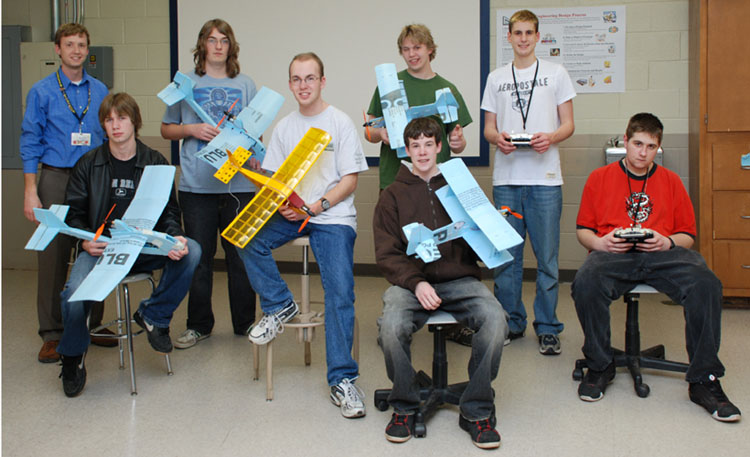|
|
As a member of the North Penn Model
Aviation Club you'll learn how to build and fly model airplanes. We have
an assortment of foam aircraft designs we build and outfit with electric
equipment. With the low prices of LiPo batteries and brushless motors,
we've added quite a few planes to our fleet. Students are responsible
for maintaining, repairing, and upgrading them as needed.
The annual membership fee is $20, and students are not asked for additional money to purchase equipment
or supplies. All club money goes directly to purchase new equipment.
Membership in the club includes a
Academy of Model Aeronautics (AMA)
license. Becoming a member of this national society provides you
with a sense of community in the model aircraft hobby, in addition to
free insurance on the rare chance that your model damages someone or
something. Returning members are not financially responsible for renewing their
membership, unless they fail to submit their forms on time.
We usually have a club t-shirt design
every few years. We embroidered our 2007-08 logo on a polo shirt, and
during 2010, we had a screen print design put on t-shirts. Students
receive a free shirt with membership as well. |
|
|
|
2003 (6 members)
I surveyed my classes to find out if anyone was interested in forming a
club which builds model aircraft. With the first few students, we built
a donated, half-assembled LT-40, although we were lacking the necessary
equipment to complete the plane. I wrote a grant to fund the engine, and
radio for that plane, as well as another 40 sized trainer, and a
flightbox for nitro planes. We sold cookies to raise money.
2004 (7 members)
The grant provided us with enough to get started, but two 40 sized
planes are very large, require a lot of room, and turn into a million
pieces when they wreck. Flights were few and far between. Selling
cookies, we raised money to purchase necessary items.
2005 (10 members)
I began experimenting with bluecor insulation to build model airplanes.
Seeing it as a cost effective method for a club, I wrote another grant
to purchase small electric equipment to build foam planes. We received
two more radios, geared electric motors, lipos, a charger, and foam.
With that we discovered how to effectively cut the foam, glue parts with
hot glue, and find free plane designs on RC Groups. The district banned
in-class food sales, so we did not sell anything.
2006 (12 members)
The focus centered around foam aircraft, and increasing club numbers. We
increased dues from $5 to $20. This increase allowed us to purchase more
radios, and keep our existing planes flying. We bought a web site
www.northpennmac.org.
2007 (15+ members)
Our efforts focused on indoor flying, and a systematic approach to the
building process. We discovered HobbyCity, and used their very low
prices to start building up our fleet of planes. The Hobby Lobby
“ESSKAY” motors were very popular, and became affordable. The club used
a few of these to build some more powerful, and agile planes. The club
hosted it’s first outdoor funfly in the spring. Unfortunately, the rain
chased us out after 45 minutes of flying. This helped us get our name
into the community. I also required each student to join the AMA, as
youth membership is only $1.
2008 (20+ members)
The club popularity grew among students, and with that increase we
decided to add two five channel Spektrum radios in addition to our 72MHz
radios. We also purchased some Parkzone planes, including a Citabria,
Cessna, and a Vapor. The club hosted it’s first indoor funfly in the
spring. It was very successful, and drew a community pilot count over
40. The money raised kept us from raising club dues.
2009-present (25+ members)
The current year is progressing well. Students send me emails showing
off their latest RC projects, while others plan to build model airplanes
to fulfill their graduation requirements. Students are joining RC
Groups, and posting questions as well as their projects. We added three
more Spektrum DX5e’s to our list of radios, as well as a replacement
Vapor. We decided to have two funfly events each year. Our winter event
drew 70+ local pilots from the surrounding states, as well as a few
sponsored pilots. The event was so well attended (crowded) that we need
to regulate our airspace for the next funfly on April 24th, 2010. Two
local hobby shops (Z’s RC, and Hobby Hut) donated equipment to raffle.
They let us keep the money, which we so desperately needed. The April
2010 event will have time slots and events to continue drawing the large
crowd we want. We’re also extending our funfly hours from 8:30am -
8:30pm (originally, 9-4pm). We’re hoping to have an air race, a micro
obstacle course, our foam carrier lighted, and flight demonstrations.
Public admission is free and a pilot flight pass only cost a $5 donation
to offset our table rental fees. Every child who visited received a free
balsa glider. |
|
